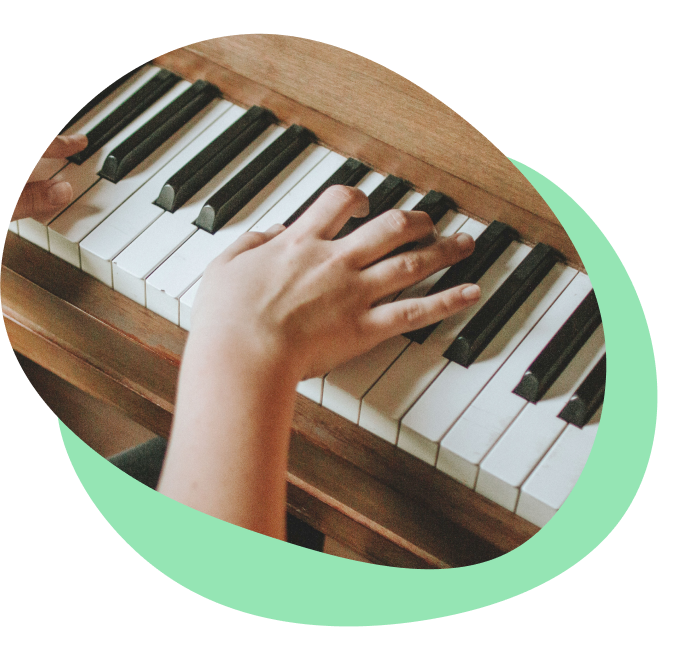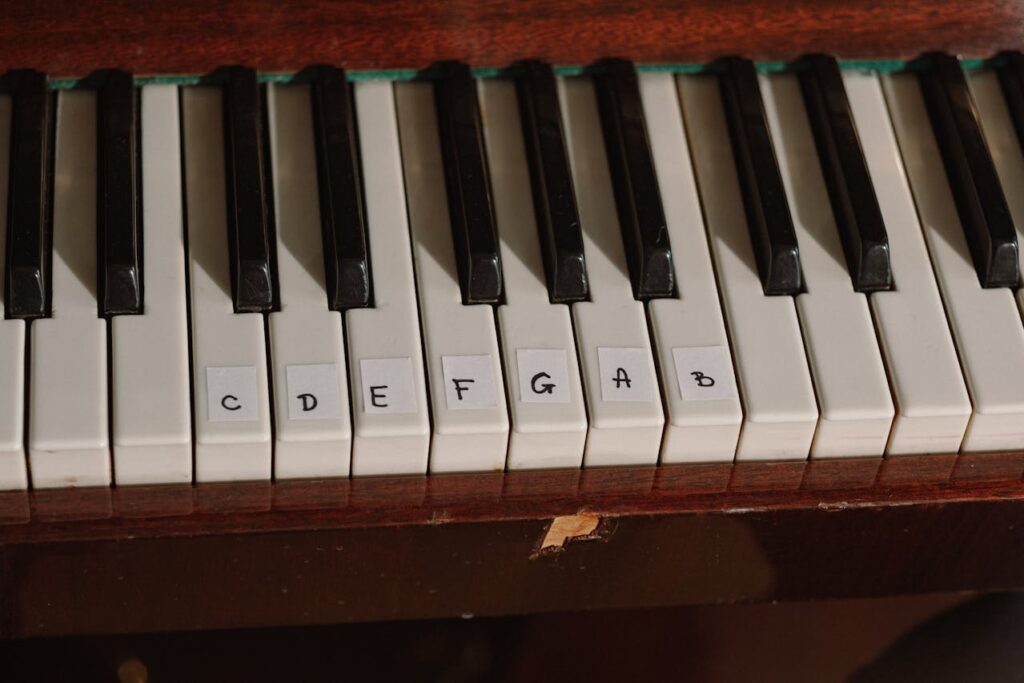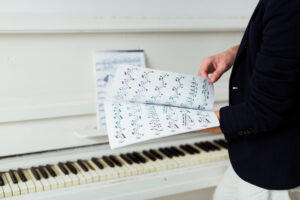Are you looking for a quick, clear guide to help you get to grips with basic piano chords? You’re in the right place. Our expert musical writers have compiled a piano chords for beginners guide which will have you understanding chords on piano and playing your favorite songs in no time.
Formed by playing two, three or more notes together, piano chords shape the emotional tone and structure of a piece. The combination of notes within a chord defines its character. In this guide, we will go over all the basics of piano chords and you will leave with a greater understanding of how you can start to use them in your piano playing today!
💡 Searching for a simple cheat sheet? You can download Skoove’s free PDF chart of piano chords right here!
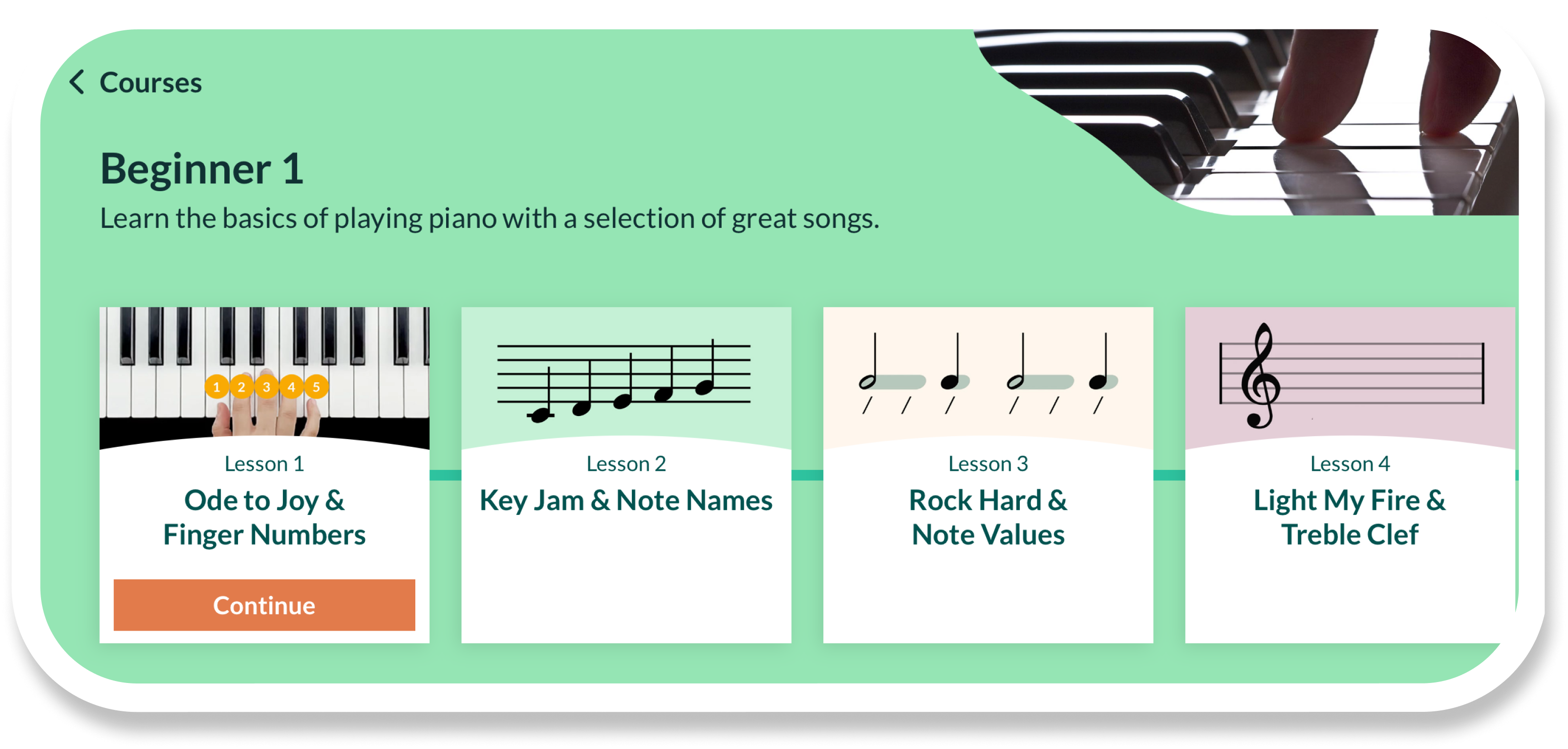
What is a piano chord?
A piano chord consists of two or more notes played simultaneously to produce harmony. The most commonly used chords in music are triads, which are made up of three notes: a root, a third and a fifth. These triads form the harmonic basis for the majority of songs. For beginners, understanding triads, learning to read piano chords and utilizing a piano chord chart can simplify the process of playing and understanding music.
Notation of piano chords
Understanding the notation system used for piano chords is essential for songwriters, producers and musicians who want to create impactful and memorable music.
Piano chords are notated using a system of letters and symbols. The letters represent the root note of the chord, while the symbols indicate the quality of the chord. For example, a C major chord is notated as C, while a C minor chord is notated as Cm. You may have noticed when playing the basic chords above that major chords sound happy while minor chords have a more somber sound.
| Chord name | Chord notation |
| C major | C |
| C minor | Cm |
Basic piano chords
Before getting into more complex harmonies, it’s important to get comfortable with some essential chords. These chords are commonly used in progressions in many songs. Once you master these commenon pano chords, you’ll be able to play thousands of songs with ease:
- C Major (C): C – E – G
- D Minor (Dm): D – F – A
- E Minor (Em): E – G – B
- F Major (F): F – A – C
- G Major (G): G – B – D
- A Minor (Am): A – C – E
All of these chords belong to the C major scale. This is why these basic piano chords all work so well together. Each key relies on its foundational triads to create harmony and tell stories through music. Have a go at exploring these chords on a piano and make your own sequences, paying attention as to how they all work together, and expand your musical vocabulary!
Piano chords chart
A piano chord chart is a great tool that can help you quickly identify and play chords. These charts show you which piano keys to press for each chord. If you’re just starting out, keeping a chord chart piano nearby as they can can be really helpful!
Reading a piano chord chart may seem tricky at first, but it becomes easier with practice. Follow these steps:
- Identify the root note (usually at the top or left of the chart).
- Recognize the chord type (major or minor).
- Observe the highlighted keys (white or black) that indicate the notes to play.
- Visualize the chord shape to guide finger placement.
- Put your fingers on the keys and press them down to make the chord sound.
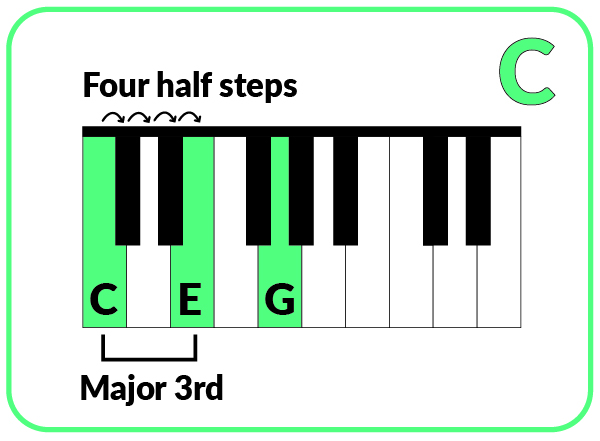 While minor chords have a minor third which is fewer steps away from the root note:
While minor chords have a minor third which is fewer steps away from the root note:
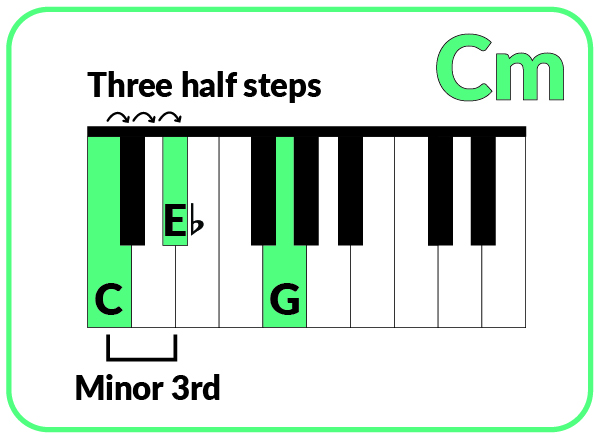
By consistently practicing with chord charts, you’ll quickly master new chords and improve your piano skills. Try out these different qualities of C chords shown above. Notice the changing difference in sound and spaces between the notes. Once you have practiced this try observing the distance between these notes and how these chords are formed. Then you can try exploring even more chords in our handy PDF of all major and minor chords!
How to build chords on the piano
To understand how chords are formed, you need to know their structure. All piano chords are built using a combination of intervals. Intervals are the way to measure the distance between two notes. The combination of these intervals forms different types of chords. To understand how chords are formed, you need to know their unique structure. Most chords are built using a combination of either major or minor thirds. Let’s take a deeper look at this with some chord diagrams.
Chord structure: root, third & fifth
The root is the note that gives the chord its name, such as ‘C’ in a C major chord. The third determines whether a chord is major or minor. In C major, ‘E’ is the third, forming a major chord. The fifth adds fullness, like ‘G’ in a C major chord.
- C Major (C – E – G) root, major third, perfect fifth
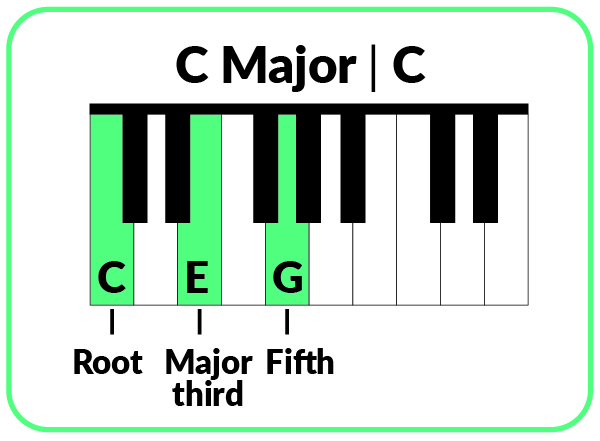
- C Minor (C – E♭ – G) root, minor third, perfect fifth
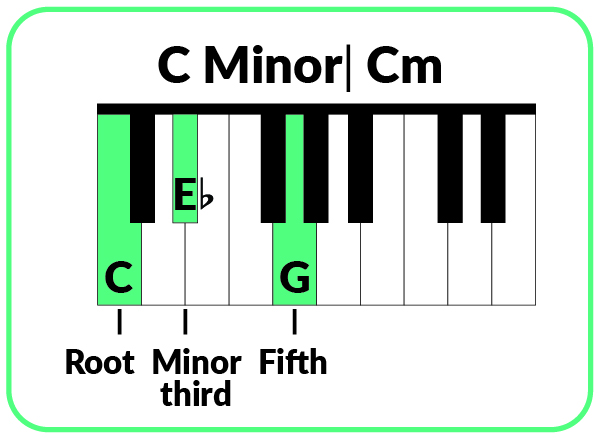
Intervals & chord formation
Chords are formed based on intervals, which measure the distance between notes. By stacking different piano intervals, you can create a variety of chords. For example, a major chord is built by stacking a major third (four steps up the scale) and a minor third (three steps). In a C major chord, the interval from C to E is a major third, while from E to G, it’s a minor third.
The root is the note that gives the chord its name, such as ‘C’ in a C major chord. The third determines whether a chord is major or minor. In C major, ‘E’ is the third, forming a major chord. The fifth adds fullness, like ‘G’ in a C major chord. You can see all these concepts in action in the above diagrams.
Inversions
Chord inversions are created by changing the order of the notes while still playing the same chord. These variations allow you to achieve different harmonic textures and smoother transitions between chords. They are a great way to add variety to your chord progressions. Have a look at the examples below:
- Root position: C – E – G
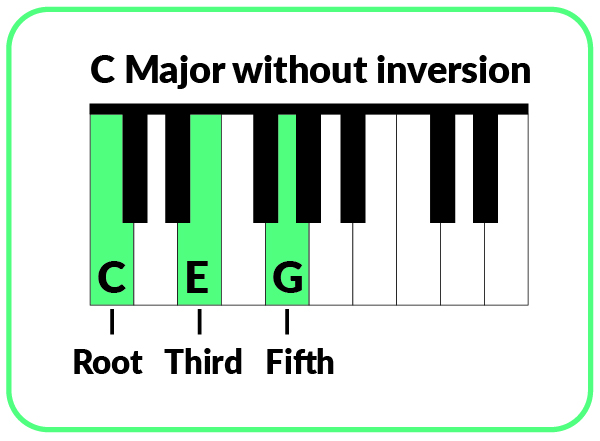
- First inversion: E – G – C
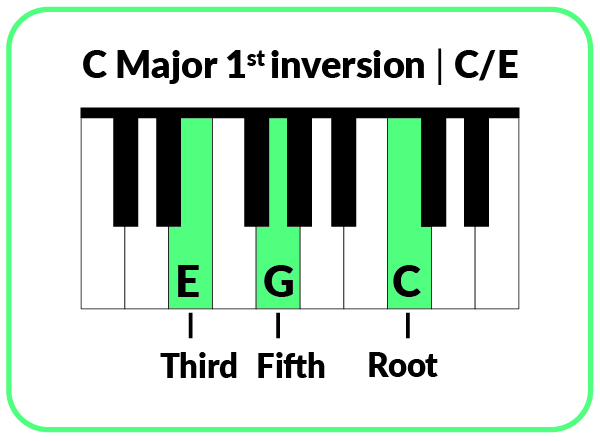
- Second inversion: G – C – E
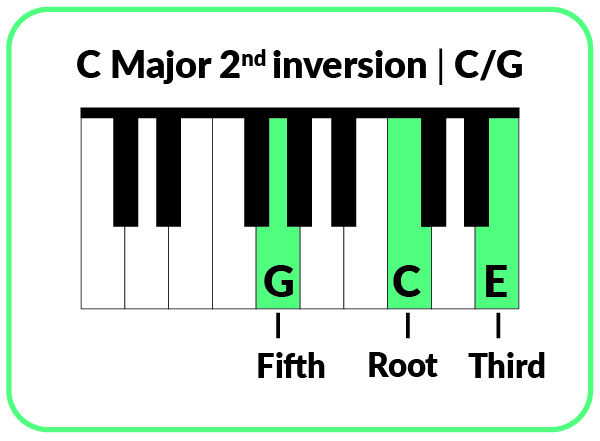
Slash chords & their uses
Slash chords are written as a fraction, like C/E, and indicate a chord played over a specific bass note. For example: C/E: A C major chord C-E-G with E as the bass note. These should not be confused with inversions. Slash chords only specify the note played in the bass and the chord quality, not the specific chord structure. Slash chords can be a great way to make your bass lines more interesting and add some movement to your chord progressions!
Mastering the basics: exploring chord qualities
Before you can start creating harmonic progressions, there are several types of chords that you should familiarize yourself with. Each one carries a unique sound and plays a distinctive role in music composition. Let’s take a closer look at these fundamental major and minor piano chords for beginners.
Major chords
Major chords have a bright and happy sound. They are built using a root note, a major third and a perfect fifth. The intervals between these notes gives major chords their distinct stable and full sound.
Major chords serve as the foundation for many songs across various genres. Because of their stability, they are often used at the start and end of chord progressions to establish a sense of resolution.
Minor chords
Minor chords contrast with major chords in that they have a darker or more somber tone. They are constructed using a root note, a minor third and a perfect fifth . While major chords use a major third, minor chords use a minor third, this gives them their distinct melancholic or introspective sound.
Minor chords can introduce a sense of tension or sadness and are commonly used to contrast major chords in progressions.
However they still can be used, as major chords are, to create resolutions. Try finishing your chord progressions with both major and minor chords. This is a great way to explore the differing qualities of these chords.
Exploring beyond basic chords
Beyond major and minor chords, there are other chord types that can add unique flavors to your chord progressions. Understanding interval notation and chord formation can help in creating these different types of chord.
Suspension chords (Sus chords)
Suspended chords replace the third with a second (sus2) or a fourth (sus4), creating a more open sound.
- Csus2: C – D – G (root, major second, perfect fifth)

- Csus4: C – F – G (root, perfect fourth, perfect fifth)

Seventh chords
Seventh chords are formed by adding a seventh to a chord which gives it a richer and more complex sound, often used in jazz, blues, and pop music.
- C7 (dominant 7th): C – E – G – Bb

- Cmaj7 (major 7th): C – E – G – B
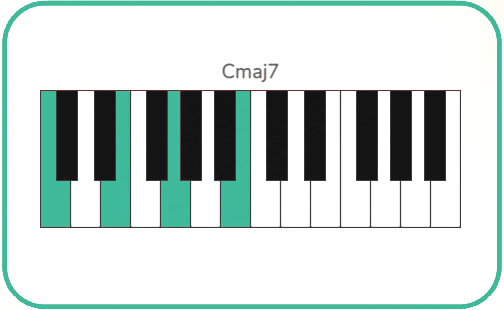
- Cm7 (minor 7th): C – E♭ – G – Bb
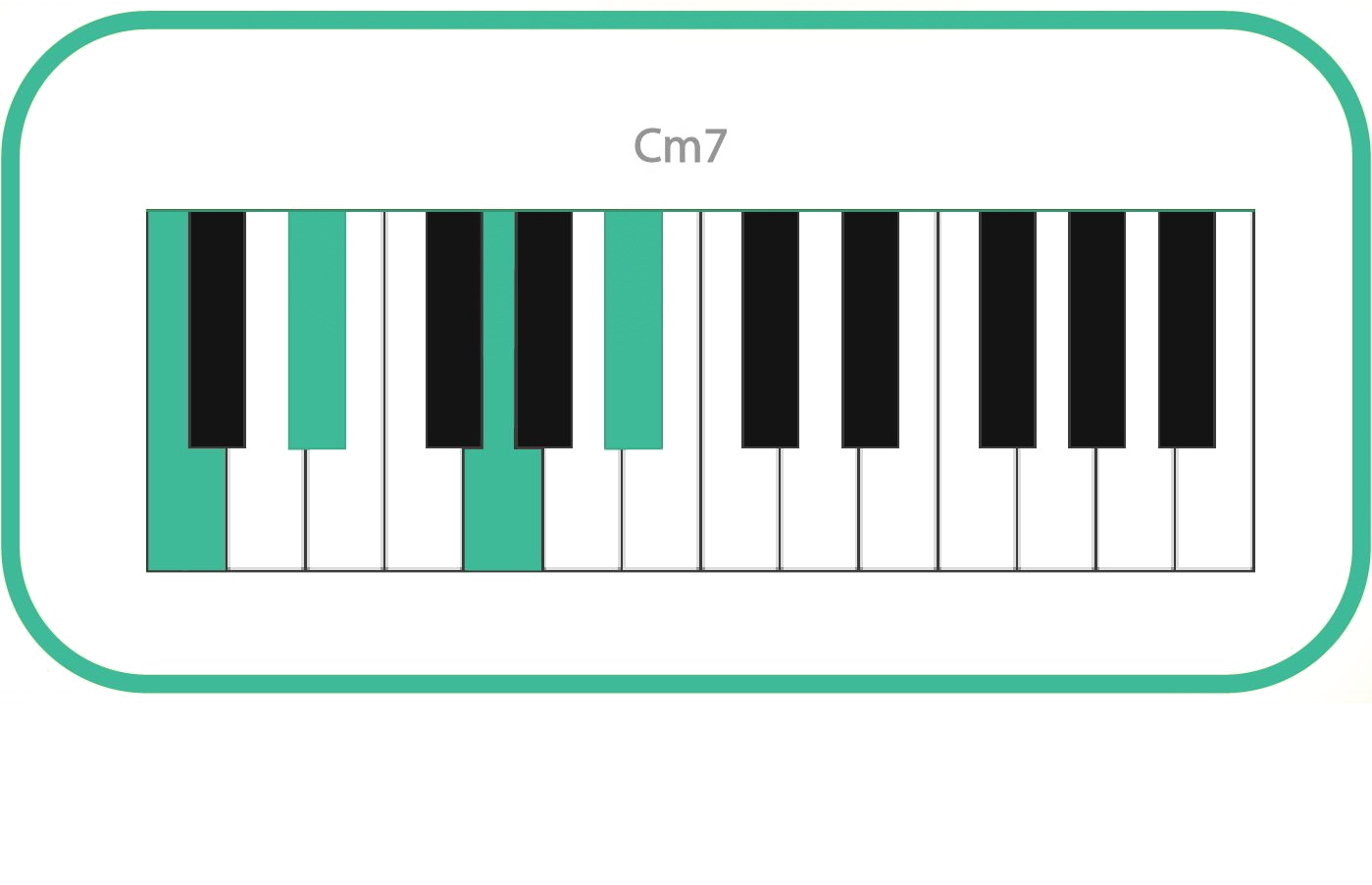
Augmented chords
Augmented chords have a raised fifth, giving them a bright and restless sound.
- Caug (C+): C – E – G♯ (root, major third, augmented fifth)
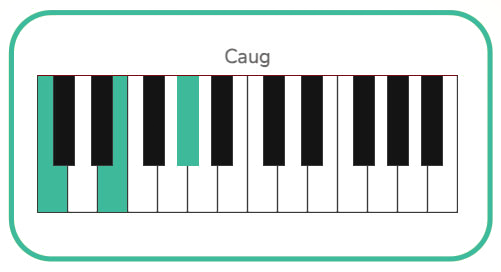
Diminished chords
Diminished chords lower both the third and fifth, creating a dark and tense sound.
- Cdim: C – E♭ – G♭ (root, minor third, diminished fifth)
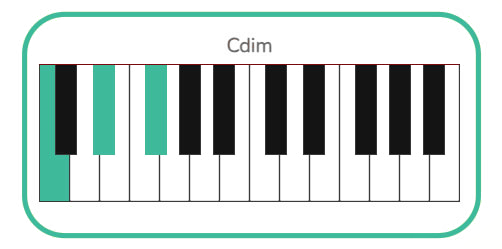
Try playing all of these new chord types and see how they differ from each other both in terms of sound and structure. Have fun experimenting with them in your playing.
How do you play a chord on the piano?
Playing a chord is simple once you understand its structure and how to build them.
Follow these steps:
- Find the root note: This is the note that gives the chord its name.
- Identify the third and fifth: These notes determine the chord’s quality.
- Use proper finger placement: Generally, use fingers 1 (thumb), 3 (middle), and 5 (pinky) for triads.
- Press all notes together: Play them at the same time for a full sound.
Get comfortable with all of these aspects of playing a chord then have fun trying it out with our case study, The Beatles’ “Let it Be”.
Case study: the impact of chords in “Let It Be” by The Beatles
“Let It Be” by The Beatles provides a clear illustration of the power and impact of piano chords in music composition.
- C major Chord (C-E-G): The song begins with a C major chord, introducing the song with a strong, happy, and uplifting mood.
- G major Chord (G-B-D): The next chord is G major, which maintains the positive vibe and serves as a perfect transition chord due to its shared notes with the C major chord.
- A minor Chord (A-C-E): The song then transitions to an A minor chord, introducing a touch of melancholy and deepening the emotional complexity of the song.
- F major Chord (F-A-C): Finally, the F major chord is introduced, resolving the minor tension and bringing back the positive mood to round up the verse.
If you’re interested in learning how to play “Let It Be” on the piano, you can check out the Let It Be piano tutorial on Skoove’s blog. You can also explore more songs with easy piano chords here.
Piano chords generator
This piano chords generator helps you to find any chord you need and will come in handy if you forget any chords along your way!
💡 If you are reading this from a mobile device, rotate it to display the tool in full width.
2. Choose the “Root” of the chord
3. Choose the “Chord qualities” (major, minor, etc.)
4. Click “Display”
* You can do the same with scales.
** You can invert chords and scales
Taking your chords to the next level
Understanding piano chords is essential, but using them effectively in your playing takes practice. Chords provide the harmonic foundation for any melody. Start by identifying the key of your melody, then experiment with different chords from that key to see how they complement the melody. Typically, melody notes align with the accompanying chord. When composing, choose a key and explore chord progressions that resonate with you. Mastering basic chords will enhance every aspect of your piano journey, as chords and melodies work hand in hand. Use this as a guide to begin your chord exploration!
FAQ
How long does it typically take to learn and master beginner piano chords?
The time required to learn and master beginner piano chords varies from person to person. With regular practice, it is possible to become comfortable with basic chords within a few weeks or months. Mastery comes with continued practice and application in different musical contexts.
What are some common mistakes beginners make when learning piano chords?
Common mistakes include neglecting proper finger placement, neglecting proper posture and hand position, not using the correct fingering for chords, and rushing through chord changes without proper accuracy and timing.
How can I practice and memorize piano chords more effectively?
Regular practice is key to memorizing piano chords. Start by practicing chords slowly and accurately, gradually increasing your speed. Practice chord progressions, both in isolation and within songs, to reinforce your chord knowledge.
Can I use a keyboard or digital piano to learn piano chords?
Absolutely! Keyboards and digital pianos are excellent instruments for learning piano chords. They often have built-in features, such as chord modes and visual aids, that can assist beginners in learning and practicing chords.
Explore all types of piano chords




